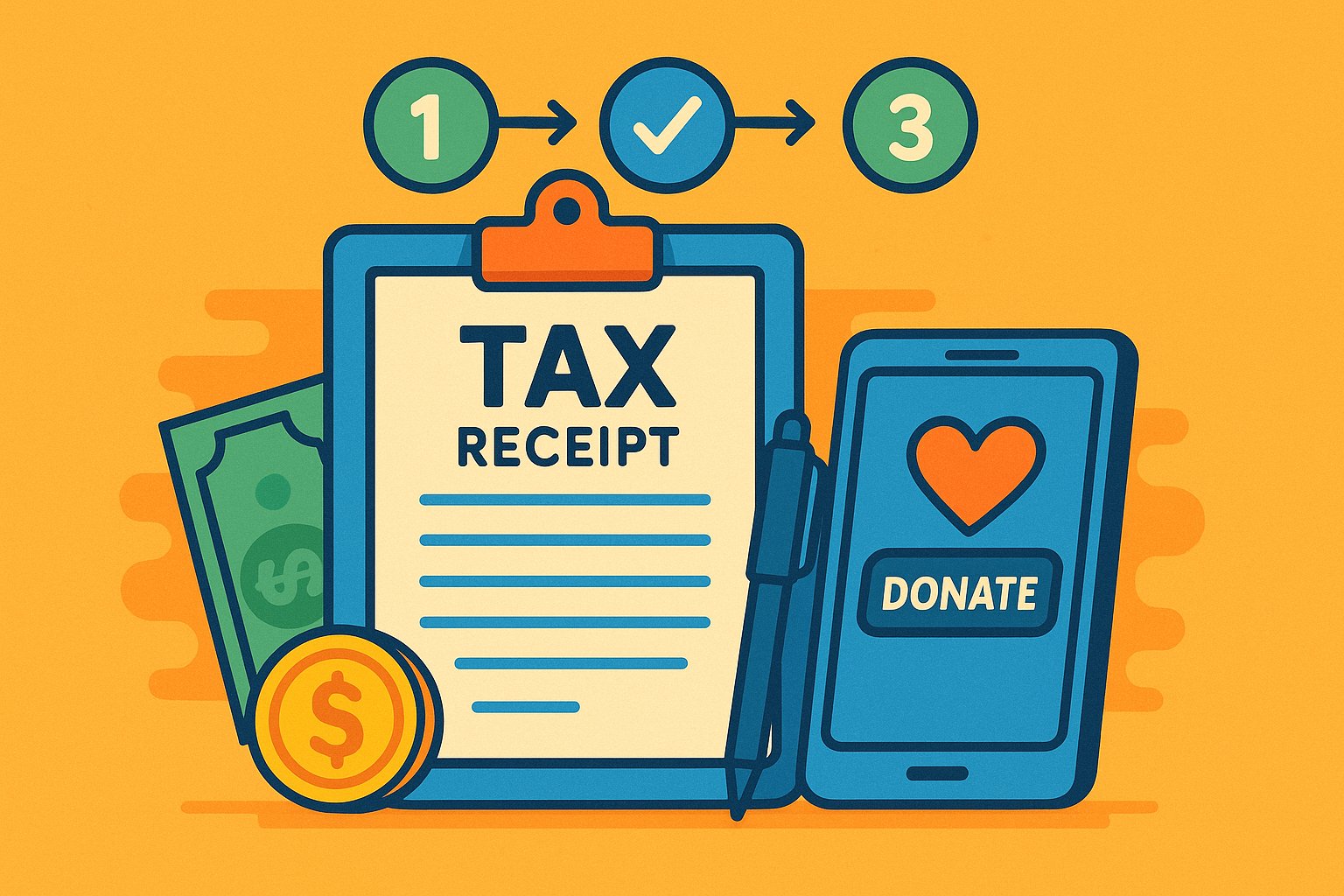Tax Receipts
Issuing tax receipts for crowdfunding donations often feels like navigating a labyrinth of rules, regulations, and best practices. Yet, for nonprofits and charitable organizations, providing accurate and timely tax receipts is not optional—it’s essential. Tax receipts reassure donors that their contributions qualify for tax deductions, bolstering trust and fostering ongoing generosity. Moreover, compliant receipts safeguard your nonprofit’s 501(c)(3) status, demonstrating transparent financial stewardship. By following a structured, step-by-step approach, you can transform what might seem like a daunting task into a seamless component of your crowdfunding strategy. This guide will walk you through the entire process—from understanding legal requirements to delivering polished, donor-friendly receipts—ensuring every supporter feels valued and every transaction aligns with IRS standards.
Decoding the Anatomy of a Tax Receipt
Before you can issue tax receipts effectively, it’s crucial to understand what constitutes a valid document. At its core, a tax receipt is a written acknowledgment that records a donor’s charitable contribution for the purpose of income tax benefits. According to IRS guidelines, each receipt must include: the nonprofit’s name and EIN (Employer Identification Number), the donor’s name, the date and amount of the donation, a statement verifying that no goods or services were provided in exchange for the gift (or detailing those goods if they were), and the nonprofit’s signature or a clearly identified representative. These elements ensure legal compliance and provide a transparent record for both donors and the IRS. Familiarizing yourself with these requirements will serve as a sturdy foundation for the steps that follow.
Laying the Groundwork: Gathering Essential Donation Data
The first practical step in issuing tax receipts is assembling accurate donation data. Start by compiling a centralized list of all crowdfunding contributions during the relevant period—often a calendar year. Extract details such as donor names, mailing addresses, email addresses, donation dates, payment methods, and exact amounts. If you’re operating on a digital crowdfunding platform, exporting this data from your platform’s backend or integrated CRM (Customer Relationship Management) system is typically straightforward. Pay special attention to recurring donations, installments, or contributions made under multiple campaigns; each qualifier must be accurately reflected. By consolidating all pertinent donation information at the outset, you minimize the risk of errors, streamline your workflow, and ensure that no donor is accidentally overlooked when issuing receipts.
Selecting the Right Tools for Receipt Generation
Once you have your data in hand, choosing the appropriate tools will simplify the receipt issuance process. Many nonprofits rely on donor management software—such as DonorPerfect, Salesforce Nonprofit Cloud, Bloomerang, or Little Green Light—which often come with built-in tax receipt templates and automated sending capabilities. If you already use an accounting system like QuickBooks Online or Wave, you can integrate it with your donor data to generate receipts. For smaller organizations, a well-designed spreadsheet paired with mail-merge functionality in Microsoft Word or Google Sheets can also suffice. Some crowdfunding platforms—like Donorbox, GoFundMe Charity, and Givebutter—offer direct receipt issuance features that automatically email tax-compliant receipts upon donation. Evaluate each tool’s cost, integration capabilities, and ease of customization to determine which best aligns with your nonprofit’s size, budget, and technical infrastructure.
Designing a Compliant, Donor-Friendly Template
With your tool chosen, the next step is crafting a tax receipt template that balances legal compliance with visual appeal. Begin by placing your nonprofit’s name, logo, and EIN prominently at the top. Below, include a clear “Tax Receipt” or “Donation Acknowledgment” header. Within the body, use an easy-to-read font to list the donor’s name and mailing address, the exact date of the contribution, and the donation amount. If no goods or services were provided, insert a statement such as, “No goods or services were provided in exchange for this contribution.” If the donor received a token gift—like a branded t-shirt or event ticket—note its fair market value and subtract it from the donation total to show the deductible portion. Conclude with a signature line or a digital signature block, the date of issuance, and a brief acknowledgment of gratitude. By combining clarity, compliance, and warmth, your template becomes a powerful tool for reinforcing donor trust.
Automating Receipt Delivery for Timely Gratification
Efficiency and promptness are key to a positive donor experience. Automating receipt delivery ensures that supporters receive their acknowledgment within days of their donation, minimizing manual workload and reducing human error. If your donor management software supports automation, set triggers to send all new donations a tax receipt email immediately. If you’re using a spreadsheet and mail-merge system, schedule a monthly or bi-weekly batch process where you export new donation data, update your mail-merge document, and dispatch emails to multiple donors at once. For crowdfunding platforms with built-in receipt functionality, verify that the “send receipt” toggle is activated and customize the email text to include personalized greetings and a brief thank-you message. By automating receipt issuance, you not only meet legal timelines—often within IRS guidelines for timely acknowledgment—but also foster a sense of instant recognition that can boost donor satisfaction.
Ensuring Accurate Recurring Donation Reporting
Recurring donors present a unique challenge: instead of issuing a single receipt, you must aggregate their annual giving into one consolidated document. Start by identifying all donors who contributed on a monthly, quarterly, or annual basis during the tax year. Sum each individual’s total contributions, ensuring that partial payments or mid-year cancellations are accurately reflected. Use your donor management system or an automated report to generate a list of donors with their aggregated amounts. In your receipt template, indicate the total amount of contributions rather than listing each installment. Some nonprofits also include a brief note—“This total reflects your monthly contributions from January 1 to December 31, 2023”—to clarify that the receipt covers multiple transactions. Accurate reporting of recurring giving bolsters transparency, preventing confusion when donors file their tax returns and reinforcing your commitment to integrity.
Navigating Goods-and-Services Valuation
Occasionally, contributors receive tangible benefits—like tickets to a fundraising gala, branded merchandise, or exclusive access to an educational webinar—in exchange for their donation. When this occurs, the IRS requires nonprofits to deduct the fair market value of those benefits from the total contribution to determine the tax-deductible portion. To navigate this process, maintain a running log of all donor benefits distributed during the year alongside their respective fair market values. When issuing a receipt, list the total donation amount followed by a line item indicating the value of goods received. For example: “Total Contribution: $200. Value of goods provided: $50. Tax-deductible amount: $150.” Providing this breakdown ensures compliance and helps donors accurately calculate their deductions. By maintaining meticulous records and transparently reporting values, you preserve donor confidence and adhere strictly to IRS guidelines.
Tailoring Delivery Methods to Donor Preferences
While email remains the most common channel for tax receipt delivery, it’s vital to accommodate donor preferences. Some individuals—especially older supporters—may prefer printed receipts via postal mail. Others may request both email and physical copies. During the donation process, include an option for donors to specify their preferred method of receipt delivery. If a donor selects postal mail, integrate your CRM with a printing and mailing service or designate a volunteer to handle weekly print-and-mail batches. For email delivery, ensure that your messages aren’t flagged as spam by verifying domain authentication and avoiding excessive sales-like language. Including a personalized subject line—such as “Your 2023 Donation Receipt from [Organization Name]”—can improve open rates. By honoring donor preferences, you demonstrate respect for individual communication styles and foster stronger connections with your supporters.
Archiving Receipts and Maintaining Audit Trails
Compliance doesn’t end once a receipt has been issued; proper record-keeping is equally essential. The IRS recommends retaining tax-exempt organization records, including tax receipts, for at least three years. Create a secure, centralized repository—either cloud-based or on-premises—that stores digital copies of all receipts. If you send physical receipts, scan them immediately and save them in your archive to ensure redundancy. Implement a consistent naming convention for file organization, such as “YYYY-DonorName-Receipt.pdf,” and tag each file with metadata indicating donation amount, date, and campaign name. In parallel, document each issued receipt in your donor database, marking the date of issuance and the method of delivery. Should the IRS request an audit, your well-maintained records will provide irrefutable proof of compliance, safeguarding your nonprofit’s 501(c)(3) status and reinforcing your credibility with donors.
Reissuing Corrected Receipts: A Process of Precision
Despite meticulous planning, mistakes can occur—typographical errors in donor names, incorrect amounts, or missing donor details. When an error is discovered, address it promptly by reissuing a corrected receipt. First, notify the donor with a sincere apology and a clear explanation of the error. In your correction email or letter, include both the original receipt number and the corrected receipt for transparency. Update your CRM records to reflect the correction and store the new receipt in your archive, noting the rationale for reissuance and the date. Communicating swiftly and with candor preserves donor trust, as supporters appreciate honesty and proactive problem-solving. By establishing a clear protocol for reissuing receipts, you minimize confusion and demonstrate that accuracy and accountability are pillars of your fiscal stewardship.
Coordinating with Tax Professionals for Complex Cases
Some crowdfunding campaigns involve nuanced scenarios—such as international donations, non-cash gifts, or crowdfunding platforms that deduct fees—where IRS regulations become intricate. In these cases, collaborating with a qualified tax advisor or financial professional is invaluable. If a donor contributes cryptocurrency, artwork, or in-kind services, the tax-deductible value may require appraisal. Likewise, if your crowdfunding platform assesses a processing fee before forwarding donations, the receipt must reflect gross contributions versus net amounts received. Engaging a tax professional ensures that your nonprofit’s receipts align with complex tax regulations. Schedule periodic consultations—especially when launching new campaign models or accepting novel donation types—to preempt compliance pitfalls. By leveraging expert guidance, you fortify your organization’s fiscal integrity and provide donors with rock-solid documentation for their tax filings.
Elevating Donor Experience with Personalized Acknowledgments
Issuing a tax receipt is also an opportunity to enhance donor relations. Pair every receipt—digital or physical—with a personalized acknowledgment that goes beyond mere compliance. Craft a brief message that highlights specific campaign milestones enabled by monthly giving or spotlights a beneficiary whose life has improved. Tailor your tone to reflect warmth and genuine appreciation, making donors feel celebrated rather than simply recorded. For major donors, consider a follow-up phone call from an executive director or a handwritten note from a program beneficiary expressing personal gratitude. This additional layer of personalization conveys that you see each supporter as more than a financial contributor; they are vital partners in effecting change. By integrating heartfelt acknowledgments into the receipt process, you shift a standard administrative step into a memorable touchpoint that catalyzes loyalty and advocacy.
Communicating Receipt Policies Transparently
Clarity is paramount when it comes to tax receipt policies. On your nonprofit’s website and crowdfunding platforms, publish a clear “Donation and Receipt Policy” that outlines key details: the timeframe within which donors can expect receipts (e.g., within 7 business days of donation), the differences between receipts for cash versus in-kind donations, and instructions for requesting duplicate copies. Address commonly asked questions—such as “What if I lose my receipt?” or “Are fees deducted from my donation receipt?”—to preempt confusion. A FAQ section prominently displayed on your donation page helps manage expectations and reduces the volume of individual inquiries. By providing transparent, accessible information about your receipt policies, you demonstrate respect for donors’ needs and cultivate a reputation for responsiveness and organizational clarity.
Timing Matters: When to Send Year-End Summaries
While issuing receipts promptly after each donation is essential, many donors also appreciate a consolidated year-end summary. This annual document combines all their donations into a single statement, simplifying tax filing. Typically sent in January or early February, the summary reiterates the total amount given during the previous calendar year and may include key impact highlights—such as program achievements, community growth metrics, or stories of transformation. By timing these annual summaries with the start of tax season, you position your nonprofit as a reliable partner in donors’ financial planning. A well-crafted year-end report also presents a powerful opportunity to remind supporters of the difference their generosity made over the past year, setting the stage for renewed commitments in the year ahead.
Integrating Continuous Improvement Through Donor Feedback
To refine your process and enhance donor satisfaction, actively solicit feedback on your receipt issuance. Include a brief survey link in your email receipts asking donors to rate clarity, timeliness, and overall satisfaction with the tax documentation. Offer a comment field where supporters can suggest improvements: perhaps they prefer mailed receipts over email, or they value more graphical elements that illustrate impact. Review this feedback quarterly, identify recurring suggestions, and implement incremental improvements—such as redesigning receipt templates for better readability or adjusting delivery timelines based on common requests. By embracing a culture of continuous improvement, you reaffirm your commitment to excellence and ensure that donors’ needs remain at the forefront of your financial stewardship.
Charting the Path to Lasting Trust
The process of issuing tax receipts for crowdfunding donations transcends mere administrative duty; it represents a pivotal opportunity to build trust, showcase transparency, and celebrate donor contributions. By following this step-by-step guide—collecting accurate donation data, selecting robust tools, designing compliant templates, and personalizing acknowledgments—you transform a regulatory requirement into a strategic advantage. Through timely issuance, clear communication, and sincere gratitude, you nurture lasting relationships, encourage recurring giving, and reinforce your nonprofit’s reputation as a diligent steward of generosity. As you hone your receipt processes, remember that each document embodies your organization’s values: accountability, respect, and partnership. By mastering the art of tax receipt issuance, you solidify the foundation for a thriving crowdfunding ecosystem, ensuring that every dollar invested propels your mission forward with unwavering integrity.




